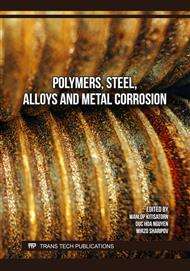[1]
H. Varghese, T. Johnson, S.S. Bhagawan, S. Joseph, S. Thomas, G. Groeninckx, Dynamic mechanical behavior of acrylonitrile butadiene rubber/poly(ethylene-co-vinyl acetate) blends, J. Polym. Sci., Part B: Polym. Phys. 40(15) (2002) 1556-1570.
DOI: 10.1002/polb.10204
Google Scholar
[2]
S.K. Sahoo, S. Mohanty, S.K. Nayak, Toughened bio-based epoxy blend network modified with transesterified epoxidized soybean oil: synthesis and characterization, RSC Advances 5(18) (2015) 13674-13691.
DOI: 10.1039/c4ra11965g
Google Scholar
[3]
M. Yamaguchi, H. Miyata, Strain Hardening Behavior in Elongational Viscosity for Binary Blends of Linear Polymer and Crosslinked Polymer, Polym. J. 32(2) (2000) 164-170.
DOI: 10.1295/polymj.32.164
Google Scholar
[4]
M. Yamaguchi, S. Ono, M. Terano, Self-repairing property of polymer network with dangling chains, Mater. Lett. 61(6) (2007) 1396-1399.
DOI: 10.1016/j.matlet.2006.07.039
Google Scholar
[5]
M. Yamaguchi, S. Ono, K. Okamoto, Interdiffusion of dangling chains in weak gel and its application to self-repairing material, Mater. Sci. Eng. B 162(3) (2009) 189-194.
DOI: 10.1016/j.mseb.2009.04.006
Google Scholar
[6]
D. Gennes, Scaling concepts in polymer physics, Cornell University Press, 2-4 Brook Stress, London, 1979.
Google Scholar
[7]
C. Fradet, F. Lacroix, G. Berton, S. Méo, E. Le Bourhis, Instrumented indentation of an elastomeric material, protocol and application to vulcanization gradient, Polym. Test. 81 (2020) 106278.
DOI: 10.1016/j.polymertesting.2019.106278
Google Scholar
[8]
X. Lv, Z. Huang, C. Huang, M. Shi, G. Gao, Q. Gao, Damping properties and the morphology analysis of the polyurethane/epoxy continuous gradient IPN materials, Compos. B Eng. 88 (2016) 139-149.
DOI: 10.1016/j.compositesb.2015.10.040
Google Scholar
[9]
M. Guvendiren, J.A. Burdick, S. Yang, Solvent induced transition from wrinkles to creases in thin film gels with depth-wise crosslinking gradients, Soft Matter 6(22) (2010) 5795-5801.
DOI: 10.1039/c0sm00317d
Google Scholar
[10]
S. Li, W. Yang, Fabrication of poly(acrylamide) hydrogels with gradient crosslinking degree via photoinitiation of thick polymer system, Polym. Adv. Technol. 22(10) (2011) 1442-1445.
DOI: 10.1002/pat.1623
Google Scholar
[11]
W. Fan, C. Shan, H. Guo, J. Sang, R. Wang, R. Zheng, K. Sui, Z. Nie, Dual-gradient enabled ultrafast biomimetic snapping of hydrogel materials, Sci. Adv. 5(4) (2019) eaav7174.
DOI: 10.1126/sciadv.aav7174
Google Scholar
[12]
Y. Ikeda, Preparation and properties of graded styrene-butadiene rubber vulcanizates, 40(4) (2002) 358-364.
DOI: 10.1002/polb.10096
Google Scholar
[13]
Y. Ikeda, Graded styrene-butadiene rubber vulcanizates, J. Appl. Polym. Sci. 87(1)(2003)61-67.
DOI: 10.1002/app.11670
Google Scholar
[14]
Q.-V. Do, T. Kida, M. Yamaguchi, K. Washizu, T. Nagase, T. Tada, Anomalous Strain Recovery after Stress Removal of Graded Rubber, Polymers, 2022.
DOI: 10.3390/polym14245477
Google Scholar
[15]
Q.-V. Do, M. Yamaguchi, K. Washizu, T. Mabuchi, T. Tada, Hysteresis manifestation of graded rubber, Polym. Adv. Technol. 35(1) (2024) e6216.
DOI: 10.1002/pat.6216
Google Scholar
[16]
T.-T. Yang, Y. Shui, C.-S. Wei, L.-Z. Huang, C.-W. Yang, G.-A. Sun, J.-J. Han, J.-Z. Xu, Z.-M. Li, D. Liu, Effect of cyclic straining with various rates on stress softening/hysteresis and structural evolution of filled rubber: A time-resolved SANS study, Compos. B Eng. 242 (2022) 110100.
DOI: 10.1016/j.compositesb.2022.110100
Google Scholar
[17]
E. Coquelle, G. Bossis, Mullins effect in elastomers filled with particles aligned by a magnetic field, Int. J. Solids Struct. 43(25) (2006) 7659-7672.
DOI: 10.1016/j.ijsolstr.2006.03.020
Google Scholar
[18]
J. Diani, B. Fayolle, P. Gilormini, A review on the Mullins effect, Eur. Polym. J. 45(3) (2009) 601-612.
DOI: 10.1016/j.eurpolymj.2008.11.017
Google Scholar
[19]
F. Bueche, Molecular basis for the Mullins effect, J. Appl. Polym. Sci. 4(10) (1960) 107-114.
Google Scholar
[20]
L. Mullins, Permanent set in vulcanized rubber, Rubber Chem. Technol. 22(4) (1949) 1036-1044.
DOI: 10.5254/1.3543010
Google Scholar
[21]
J. Diani, M. Brieu, P. Gilormini, Observation and modeling of the anisotropic visco-hyperelastic behavior of a rubberlike material, International Journal of Solids Structures 43(10) (2006) 3044-3056.
DOI: 10.1016/j.ijsolstr.2005.06.045
Google Scholar
[22]
P.J. Flory, Principles of polymer chemistry, Ithaca : Cornell University Press, 1953.1953.
Google Scholar
[23]
P.J. Flory, J. Rehner, Jr., Statistical Mechanics of Cross‐Linked Polymer Networks II. Swelling, J. Chem. Phys. 11(11) (1943) 521-526.
DOI: 10.1063/1.1723792
Google Scholar
[24]
T. Tanaka, S.-T. Sun, Y. Hirokawa, S. Katayama, J. Kucera, Y. Hirose, T. Amiya, Mechanical instability of gels at the phase transition, Nature 325(6107) (1987) 796-798.
DOI: 10.1038/325796a0
Google Scholar
[25]
W. Hong, Z. Liu, Z. Suo, Inhomogeneous swelling of a gel in equilibrium with a solvent and mechanical load, Int. J. Solids Struct. 46(17) (2009) 3282-3289.
DOI: 10.1016/j.ijsolstr.2009.04.022
Google Scholar
[26]
Z. Wu, N. Bouklas, R. Huang, Swell-induced surface instability of hydrogel layers with material properties varying in thickness direction, Int. J. Solids Struct. 50(3) (2013) 578-587.
DOI: 10.1016/j.ijsolstr.2012.10.022
Google Scholar
[27]
F. Weiss, S. Cai, Y. Hu, M. Kyoo Kang, R. Huang, Z. Suo, Creases and wrinkles on the surface of a swollen gel, J. Appl. Phys. 114(7) (2013) 073507.
DOI: 10.1063/1.4818943
Google Scholar



